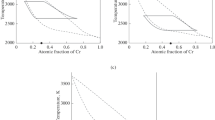Abstract
A thermodynamic analysis of phase transformations of nanoparticles under hydrostatic pressure has revealed important differences between phase transformations under isothermal or adiabatic conditions. This presuppositionless analysis fully explains a hysteresis with respect to the phase fraction and the pressure observed experimentally. It is important to mention that the results of this analysis may be transferred to the role of any external volumetric field acting on phase transforming nanoparticles. Typical examples are phase transformations of ferromagnetic intermetallics subjected to the influence of magnetic fields.










Similar content being viewed by others
References
Carslaw HS, Jaeger JC (1976) Conduction of heat in solids, 2nd edn. Clarendon Press, Oxford. Reprint, sect. 9.4
Chen C-C, Herhold AB, Johnson CS, Alivisatos AP (1997) Size dependence of structural metastability in semiconductor nanocrystals. Science 276:398–401
Frank Ph, von Mises R (1961) Die Differential- und Intergralgleichungen der Mechanik und der Physik, vol II, sect. XIII, §2, equ. (49). Dover Publication Inc, New York
Kim J-H, Fukuda T, Kakeshita T (2006) Effects of magnetic field and hydrostatic pressure on the martensitic transformation temperature of Ni–Mn–Ga ferromagnetic shape memory alloys. Mater Sci Eng A 438–440:952–956
Vollath D, Fischer FD (2009a) Structural fluctuations in ensembles of nanoparticles. J Nanopart Res 11:647–654
Vollath D, Fischer FD (2009b) Bistability, hysteresis and fluctuations in adiabatic ensembles of nanoparticles. J Nanopart Res 11:1485–1500
Vollath D, Szabó DV (1994) Nanocoated particles: a special type of ceramic powder. Nanostruct Mater 4:927–938
Vollath D, Szabó DV (1998) Synthesis of coated nanoparticulate ceramic powders. In: Materials Research Society symposium proceedings vol 520, pp 143–148
Wales DJ, Berry RS (1994) Coexistence in finite systems. Phys Rev Lett 73:2875–2878
Author information
Authors and Affiliations
Corresponding author
Additional information
Remark: Within this paper, upper case letters are referring to one mol of material; lower case letters refer to one particle. All the calculations within this contribution are based on a synthetic set of data (see Appendix 2) because, until now, there is no sufficiently complete data set for a real material available.
Appendices
Appendix 1: Heat transfer of a particle to its environment
Let us consider a spherical particle with radius R, the thermal conductivity λ and the dimension-free thermal diffusivity \( \tilde{\kappa }\left( {\tilde{\kappa } = \lambda /\left( {\rho_{p} c_{{{F}, {p} }} R^{2} } \right),\;\rho_{p} \;{\text{density,}}\;c_{{F, {p} }} \;{\text{specific}}\;{\text{heat}}} \right). \) The sphere has an initial, relative temperature T 1. The actual temperature T at a position ρ = r/a with r being the radial distance, 0 ≤ ρ ≤ 1, is denoted as \( T_{1} \tilde{T}\;{\text{with}}\;\tilde{T} \) being a dimension-free temperature.
As first case, we study the heat transfer to the environment, staying at a temperature T = 0, performed by convection with a heat flux \( \lambda \partial \tilde{T}/\partial \rho = - Rh\tilde{T} \) at the surface of the particle; h is the heat transfer coefficient. The solution of this problem can be found in Carslaw and Jaeger (1976), with a dimension-free time \( \tau = t\tilde{\kappa } \) with t being the actual time. The average temperature \( \tilde{T}_{\text{av}} \) in the spherical particle can be reported as
The quantity α n is the n-th root of the equation \( \alpha_{n} {\text{cotan }}\left( {\alpha_{n} } \right) + \left( {Rh/\lambda - 1} \right) = 0. \) For Rh/λ ≪ 1 a series development of the a.m. transcendent equation yields \( \alpha_{1} \sim \sqrt {3Rh/\lambda } \). For the roots α i , i ≥ 2, an estimation α i ~ 4.49 + (i − 2)π exists. Therefore, the multiplier of \( \exp \left( { - \alpha_{n}^{2} \tau } \right) \) decreases in the order of 1/n 4, which yields a quick convergence of the series. In many practical cases it is, therefore, sufficient to use as an estimation of \( \tilde{T}_{\text{av}} \) the first term of the series in (17), which follows from a binomial series developments and some analysis as
Taylor series development of the first term in (18) yields
As second case, we study the heat transfer to a matrix, in which the particle is embedded, with the same thermal properties as the particle. An exact analytical solution for this problem can be found in Frank and Mises (1961) as
The function erf(x) is the error function of the argument x. The average temperature \( \tilde{T}_{\text{av}} \) in the spherical particle can be found by integration as
For a short time period τ the average temperature can be approximated as
Appendix 2
Thermodynamic data used for the model calculations
Due to a lack of a consistent set of thermodynamic data for nanomaterials in the open literature, an artificial data set was developed that allows the demonstration of the properties of phase transformations in different enclosures. The following values are selected:
-
Material data:
Density: ρ = 5,000 kg m−3
Density ratio: ρ2/ρ1 = 0.91
Molecular weight: M = 0.05 kg mol−1
Surface energy phase 1: γ1 = 1.0 J m−2
Surface energy phase 2: γ1 = 1.1 J m−2
-
Thermodynamic data:
Enthalpy phase 1: u 1 = 0 J mol−1 (Reference state)
Enthalpy phase 2: u 2 = 6,000 J mol−1
Entropy phase 1: s 1 = 34 J T−1 mol−1
Entropy phase 2: s 2 = 40 J T−1 mol−1
Heat capacity: \( c_{p} = 25[{{{\left( {D_{1} - 2 \times 10^{ - 9} } \right)^{3} + 1.2\left( {D_{1}^{3} - \left( {D_{1} - 2 \times 10^{ - 9} } \right)^{3} } \right)} /{D_{1}^{3} }}}] \)
This formula meets approximately the influence of the surface on the heat capacity, assuming a surface layer of 1 nm thickness with increased heat capacity; D 1 is the diameter of the particle in phase 1 in meter.
Rights and permissions
About this article
Cite this article
Vollath, D., Fischer, F.D. Phase transformations of nanoparticles exposed to hydrostatic pressure. J Nanopart Res 12, 1859–1868 (2010). https://doi.org/10.1007/s11051-009-9747-2
Received:
Accepted:
Published:
Issue Date:
DOI: https://doi.org/10.1007/s11051-009-9747-2




